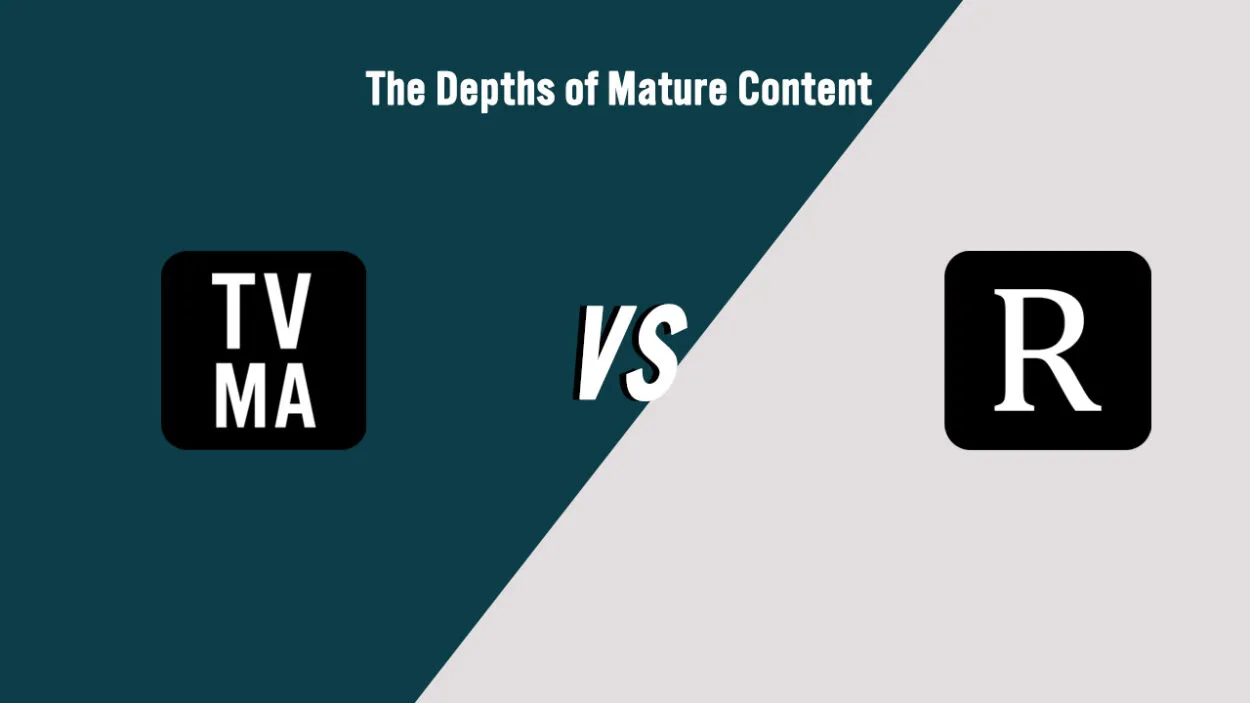When you watch TV or movies, you see little letters at the corner of the screen that seems pretty irrelevant to the content you’re watching. But the thing is, they’re very relevant. Those little letters are ratings to tell you how audience-appropriate the content is. There are quite a few of these ratings.
You may think these ratings are unnecessary. But, if they didn’t exist, we wouldn’t know if the content we’re about to watch is appropriate enough for us or the people we’re watching it with or not.
The ratings give us a heads-up about what we’re about to watch and keep the younger audience safe from watching inappropriate content at a young age.
The article will mainly focus on:
| Contents of Article | Explanation |
| What TV maturity ratings are? | TV ratings exist to let the audience know what age the program they are watching is suitable for. |
| The six TV ratings and one R rating | TV-Y, TV-Y7, TV-G, TV-PG, TV-14, TV-MA, R rating |
| TV-MA is more explicit in comparison to R; however, there’s more to it. | An in-depth look into these three ratings |
| Is TV Ma Worse Than R? | TV-MA is more explicit in comparison to R however, there’s more to it. |
To find out what they actually mean, please continue reading the article.

By continuing to use this website you agree to our Terms of Use. If you don't agree to our Terms, you are not allowed to continue using this website.
TV Maturity Ratings
TV shows and movies are mostly classified into different ratings for every age type so that people don’t end up watching content that isn’t appropriate for them.
On December 19, 1996, the TV Parental Guidelines, an American television content rating system, were first put forward.
TV ratings exist to let the audience know what they’re getting themselves into. Without the ratings, the content of movies would be unsafe to younger audiences, and they could watch stuff they’re not supposed to.
TV ratings help parents to know what’s appropriate enough for their children. It helps in keeping children safe from inappropriate content. There are six TV ratings referring to the age group and its appropriate content.
The six TV and one R rating are as follows:
TV-Y
This rating gives no restrictions and is for all ages to watch.
TV-Y7
This rating is designed for children above the age of seven as it includes content that may not be understood by children who cannot distinguish between fantasy and reality, and some of the content may include comedic violence that wouldn’t be suitable for children under seven.
TV-G
This rating is suitable for all ages but doesn’t necessarily interest children. Parents would let their kids watch this content unattended because it doesn’t include anything inappropriate such as violence, bad language, or sexual content.
TV-PG
This rating is to be watched under the supervision of an adult as it may include mild violence, infrequent inappropriate language and may contain a little sexual content.
TV-14
This rating contains content parents would find unsuitable for children under 14. This may include suggestive dialogue, inappropriate language, intense sexual situations, or violence.
TV-MA
This rating is unsuitable for people under 17 and is mostly made to be viewed by adults. It may include explicit language and sexual content, and graphic violence.
R rating
This rating and TV-MA are equivalent to each other, but R is comparatively more appropriate.
If you want to learn more about the maturity ratings in the media we consume nowadays, do look into this study by Douglas A. Gentile called “Media Ratings for Movies, Music, Video Games, and Television”
Before we can compare TV-MA and R ratings, we first need to dive into and learn about the following ratings more deeply:
- TV-MA
- R rating
- NC-17
Tv-Ma, R, Nc-17 Ratings in Depth

TV-MA
TV-MA is a television rating. This rating is just to alert you that the content you’re about to watch isn’t suitable for audiences under 17.
It may include explicit language and sexual content, and graphic violence. The rating is an abbreviation for “Mature Audience. “ This rating is the most extreme of all the ratings.
R rating
R is a movie rating. This rating lies between PG-13 and NC-17. Where it means it’s not suitable for audiences under 13 but can be suitable for those under 17.
For the under-17 audience, it is suggested that they watch it under the supervision of an adult as it contains graphic content such as nudity, sexual content, inappropriate language, and intense violence that may include blood and gore.
NC-17
A movie with an NC-17 rating is one that the Rating Board believes is too mature for viewers who are 17 and younger. Under no circumstances is anyone under the age of 18 permitted in theatres.
NC-17 shouldn’t be interpreted as a negative rating in any way. It doesn’t mean “obscene” or “pornographic” in the common or legal sense of those words.
This grade merely indicates that the material is only suitable for an adult audience (ages 18 and above). The majority of movies with an NC-17 rating have graphic sexual content.

Contrasting TV-MA and R
They both are fairly very similar. TV-MA is equivalent to R, just a little more extreme.
The first difference is that TV-MA is a TV broadcasting rating, but R is a film rating. The second difference would be TV-MA being the most extreme TV rating to exist, while R is only the second most extreme film rating.
NC-17 is the most extreme rating for the film. A TV show that’s rated TV-MA mostly includes R and NC-17 content both, this is how it’s proven to be the most extreme rating.
Now that we have learned about both the ratings and know their differences let’s move on to our main subject.
Is TV Ma Worse Than R?
R and TV-MA have very similar, if not identical, appearances. However, TV-MA is more explicit in comparison to R; therefore, we can conclude that it is worse.
R is merely the second extreme rating for television, whereas TV-MA is the most extreme. TV-MA is worse than R because it contains both R and NC-17-rated material.
R is OK for viewers under 17 as long as an adult accompanies them, but TV-MA is never appropriate for viewers under 18. Only adults are permitted to watch TV-MA.
Different views on TV-MA and R ratings:
| Viewpoints | Description | Reference |
|---|---|---|
| Common Sense Media | TV-MA is intended for mature audiences, indicating higher levels of violence, sexual content, or language. | Common Sense Media – TV Ratings Guide |
| Motion Picture Association (MPA) | The R rating for films indicates adult material and is suitable for viewers who are 17 or accompanied by an adult. | Motion Picture Association – Film Ratings |
| Parental Guidance | TV-MA and R ratings provide guidance for parents in making informed decisions about content suitability for their children. | Parental Guidance – TV Ratings |
| Age Restrictions and Viewer Safety | TV-MA and R ratings serve as safeguards, protecting younger viewers from potentially inappropriate or distressing content. | American Academy of Pediatrics – Media and Children |
| Criticism of Inconsistencies | Some critics argue that the application of TV-MA and R ratings can be inconsistent across different platforms or cultural contexts. | The Guardian – “Censorship in Hollywood” |
FAQs
Do Ratings Exist That Are Specifically Designed for Children?
There are two categories used to rate children’s programming, TV-Y and TV-Y7.
Programs with a TV-Y rating are suitable for kids of all ages. TV-Y7 designates that the content is intended for kids aged seven and up.
When a show incorporates “fantasy violence” that is more severe or aggressive than other TV-Y7 programs, it’s given the extra classification TV-Y7-FV. So in simpler words, the answer is yes, these ratings do exist.
How Are TV Ratings Displayed?
In the first 15 seconds of the broadcast, a rating symbol is displayed in the top left corner of the TV. The symbol will return at the start of the second hour if the show is longer than an hour.
After each commercial break, a lot of broadcast and cable television networks also show the rating.
Are All TV Programs Rated?
The majority of TV shows must abide by the Guidelines. Sports and news are exempt from the TV rating system, though.
Additionally, some programming genres don’t normally carry a rating, such as religious and home shopping broadcasts.
What Are TV Ratings?
TV Ratings, commonly known as the TV Parental Guidelines, include details on the subject matter and age suitability of TB programs.
Two components make up the TV Parental Guidelines: a maturity level rating that specifies the target audience for a show and content descriptors that indicate if a program may contain suggestive dialogue (D), harsh or vulgar language (L), sexual situations (S), or violence (V).
Conclusion
- The TV Parental Guidelines were first put forward on December 19, 1996. There are six different TV ratings, to be exact, that tell which content is appropriate for which age group. Ratings help parents know what is appropriate enough for their children and help keep them safe from inappropriate content.
- TV-MA is an abbreviation for Mature Audience. This rating is just to alert you that the content you’re about to watch isn’t suitable for audiences under 17.
- R is a movie rating. This means it’s not suitable for audiences under 13. For the under-17 audience, it is suggested that they watch it under the supervision of an adult as it contains graphic content such as nudity and violence.
- TV-MA is worse than TV-R because it contains both R and NC-17-rated material. Only adults are permitted to watch TV-MA, and viewers under 18 must be accompanied by an adult or are required to be a member of the adult audience.
Other Articles
- How to Fix Your Vizio TV Sound? (Easy Solution)
- Why Are My AirPods So Quiet? (An In-Depth Look)
- How To Sync Roku Remote Without a Pairing Button (3 Working Methods!)

